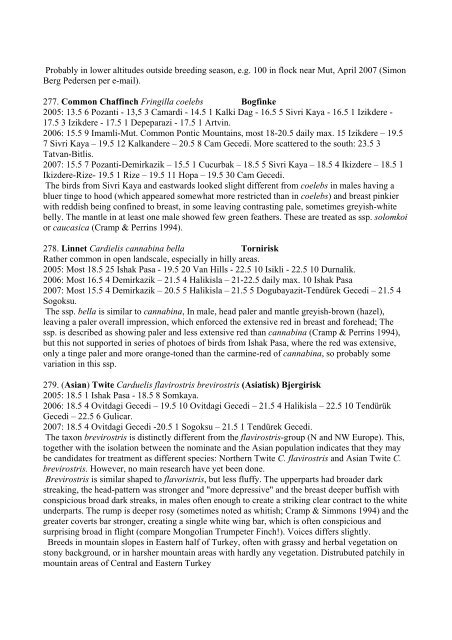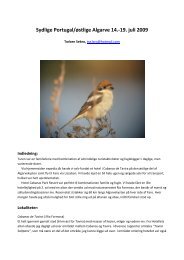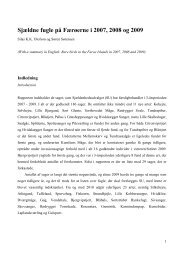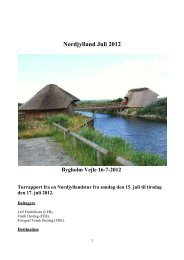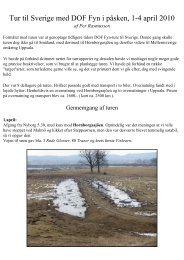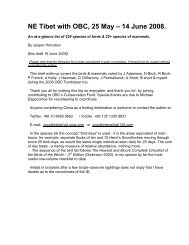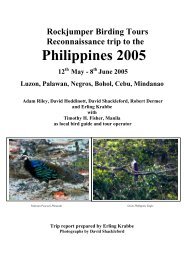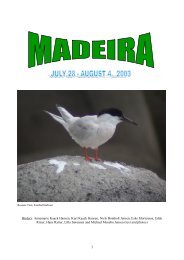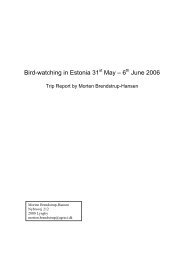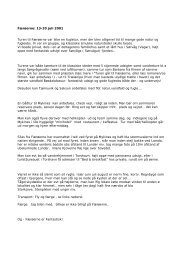TURKEY - a report from a birdwatching trip to Central ... - Netfugl.dk
TURKEY - a report from a birdwatching trip to Central ... - Netfugl.dk
TURKEY - a report from a birdwatching trip to Central ... - Netfugl.dk
You also want an ePaper? Increase the reach of your titles
YUMPU automatically turns print PDFs into web optimized ePapers that Google loves.
Probably in lower altitudes outside breeding season, e.g. 100 in flock near Mut, April 2007 (Simon<br />
Berg Pedersen per e-mail).<br />
277. Common Chaffinch Fringilla coelebs Bogfinke<br />
2005: 13.5 6 Pozanti - 13,5 3 Camardi - 14.5 1 Kalki Dag - 16.5 5 Sivri Kaya - 16.5 1 Izikdere -<br />
17.5 3 Izikdere - 17.5 1 Depeparazi - 17.5 1 Artvin.<br />
2006: 15.5 9 Imamli-Mut. Common Pontic Mountains, most 18-20.5 daily max. 15 Izikdere – 19.5<br />
7 Sivri Kaya – 19.5 12 Kalkandere – 20.5 8 Cam Gecedi. More scattered <strong>to</strong> the south: 23.5 3<br />
Tatvan-Bitlis.<br />
2007: 15.5 7 Pozanti-Demirkazik – 15.5 1 Cucurbak – 18.5 5 Sivri Kaya – 18.5 4 Ikizdere – 18.5 1<br />
Ikizdere-Rize- 19.5 1 Rize – 19.5 11 Hopa – 19.5 30 Cam Gecedi.<br />
The birds <strong>from</strong> Sivri Kaya and eastwards looked slight different <strong>from</strong> coelebs in males having a<br />
bluer tinge <strong>to</strong> hood (which appeared somewhat more restricted than in coelebs) and breast pinkier<br />
with reddish being confined <strong>to</strong> breast, in some leaving contrasting pale, sometimes greyish-white<br />
belly. The mantle in at least one male showed few green feathers. These are treated as ssp. solomkoi<br />
or caucasica (Cramp & Perrins 1994).<br />
278. Linnet Cardielis cannabina bella Tornirisk<br />
Rather common in open landscale, especially in hilly areas.<br />
2005: Most 18.5 25 Ishak Pasa - 19.5 20 Van Hills - 22.5 10 Isikli - 22.5 10 Durnalik.<br />
2006: Most 16.5 4 Demirkazik – 21.5 4 Halikisla – 21-22.5 daily max. 10 Ishak Pasa<br />
2007: Most 15.5 4 Demirkazik – 20.5 5 Halikisla – 21.5 5 Dogubayazit-Tendürek Gecedi – 21.5 4<br />
Sogoksu.<br />
The ssp. bella is similar <strong>to</strong> cannabina, In male, head paler and mantle greyish-brown (hazel),<br />
leaving a paler overall impression, which enforced the extensive red in breast and forehead; The<br />
ssp. is described as showing paler and less extensive red than cannabina (Cramp & Perrins 1994),<br />
but this not supported in series of pho<strong>to</strong>es of birds <strong>from</strong> Ishak Pasa, where the red was extensive,<br />
only a tinge paler and more orange-<strong>to</strong>ned than the carmine-red of cannabina, so probably some<br />
variation in this ssp.<br />
279. (Asian) Twite Carduelis flavirostris brevirostris (Asiatisk) Bjergirisk<br />
2005: 18.5 1 Ishak Pasa - 18.5 8 Somkaya.<br />
2006: 18.5 4 Ovitdagi Gecedi – 19.5 10 Ovitdagi Gecedi – 21.5 4 Halikisla – 22.5 10 Tendürük<br />
Gecedi – 22.5 6 Gulicar.<br />
2007: 18.5 4 Ovitdagi Gecedi -20.5 1 Sogoksu – 21.5 1 Tendürek Gecedi.<br />
The taxon brevirostris is distinctly different <strong>from</strong> the flavirostris-group (N and NW Europe). This,<br />
<strong>to</strong>gether with the isolation between the nominate and the Asian population indicates that they may<br />
be candidates for treatment as different species: Northern Twite C. flavirostris and Asian Twite C.<br />
brevirostris. However, no main research have yet been done.<br />
Brevirostris is similar shaped <strong>to</strong> flavoristris, but less fluffy. The upperparts had broader dark<br />
streaking, the head-pattern was stronger and "more depressive" and the breast deeper buffish with<br />
conspicious broad dark streaks, in males often enough <strong>to</strong> create a striking clear contract <strong>to</strong> the white<br />
underparts. The rump is deeper rosy (sometimes noted as whitish; Cramp & Simmons 1994) and the<br />
greater coverts bar stronger, creating a single white wing bar, which is often conspicious and<br />
surprising broad in flight (compare Mongolian Trumpeter Finch!). Voices differs slightly.<br />
Breeds in mountain slopes in Eastern half of Turkey, often with grassy and herbal vegetation on<br />
s<strong>to</strong>ny background, or in harsher mountain areas with hardly any vegetation. Distrubuted patchily in<br />
mountain areas of <strong>Central</strong> and Eastern Turkey


